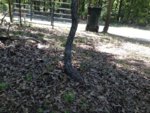I've had some dieback on smaller branching, but extremely strong push of new foliage on extension growth from last summer. I haven't messed with the roots at all despite the deteriorating collection pot. I am being pretty cautious in how I'm going at it. With this past winter's extremely unpredictable weather pattern, I've been even more cautious--just let it grow.
The new growth this spring was encouraging, however, some of the initial leaves had the same grey out as the leaves that were on it last summer--I suspect a fungal issue. However, since that initial problem, the tree put on dense growth
There seem to be two growth periods, as far as I can see. Early spring and mid-summer, which would make sense in timing--springtime rain, and the summer monsoon season in its native habitat. Stronger, but more localized, growth in the summer period.
As it did last June/July, the tree is pushing new growth on the two foot long extension shoots it grew out last summer. That new growth on the stronger shoots is moving at a half inch per day at this point. I expect them to extend as far as the shoots did last year.
I have been fertilizing with low phosphorous ferts at full strength all summer once a week. It's not a problem as the pumice drains pretty freely.
Insects don't like this tree --at all. Have had only a couple try to chew leaves, but they moved on since the leaves are thick and tough. Along with the fert, I'm also supplementing with Epsom salts every other week--a half teaspoon to a gallon. That helps toughen up the leaves. I do that for all my trees. Works OK.
Obviously, 'll have to post a photo soon.
This species is interesting. Dropping finer branches seems to be in its DNA, given the extensive deadwood on all of these I've seen. That wouldn't be surprising, as its native habitat would force that kind of thing, same as desert juniper species with their deadwood. Surprisingly, or maybe not, the tree seems to like water. I was trying to let the soil dry down, but wound up killing some new growth in early spring. I water every day, sometimes twice in this ungodly heat. Also covering the pot with a white cloth if the temps are forecast to top 90.





















